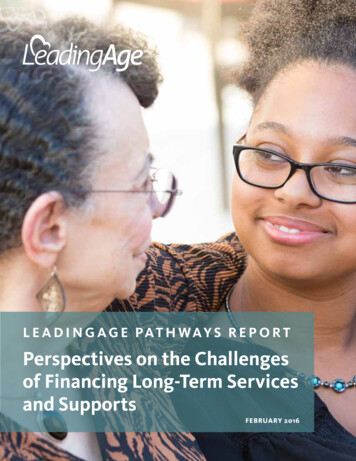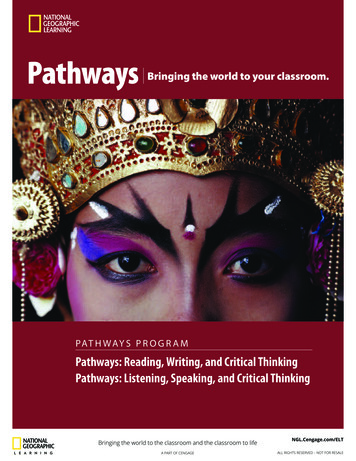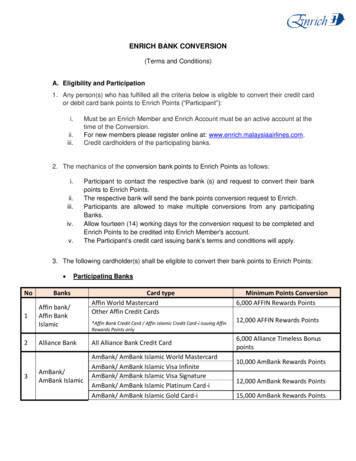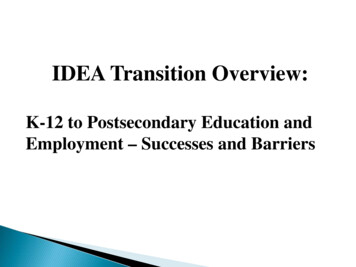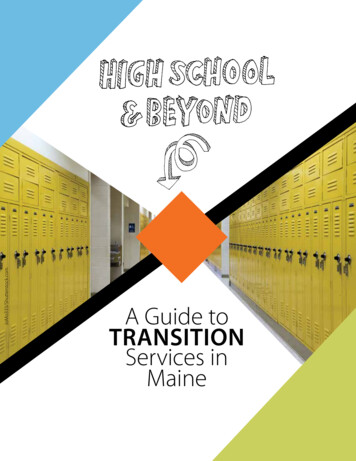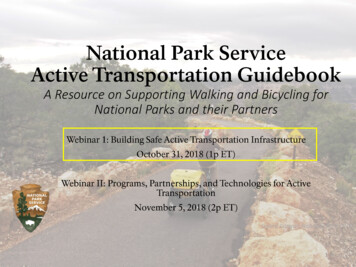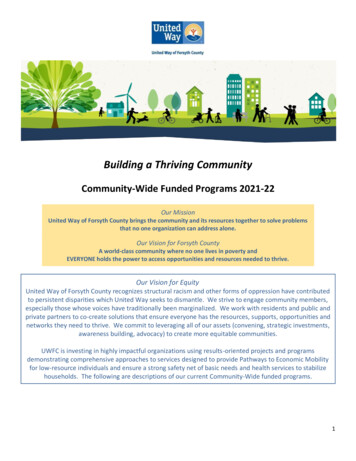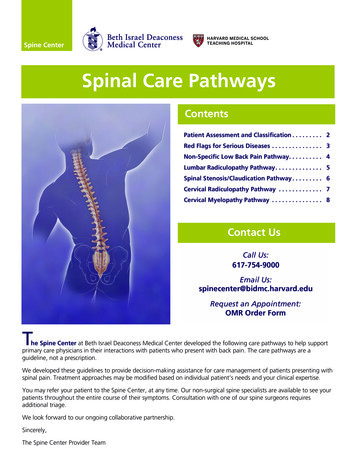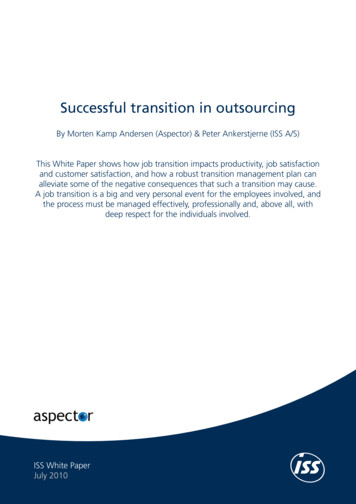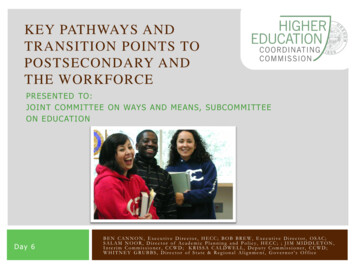
Transcription
KEY PATHWAYS ANDTRANSITION POINTS TOPOSTSECONDARY ANDTHE WORKFORCEPRESENTED TO:JOINT COMMITTE E ON WAYS AND MEANS, SUBCOMMITTEEON EDUCATI OND ay 6BEN CANNON, Executive Director, HECC; BOB BREW, Executive Director, OSAC;SALAM NOOR, Director of Academic Planning and Policy, HECC; ; JIM MIDDLETON,Interim Commissioner, CCWD; KRISSA CALDWELL, Deputy Commissioner, CCWD;WHITNEY GRUBBS, Director of State & Regional Alignment, Governor’s Office
A CONS OLIDAT ED P OS TSE CONDARY P R E S ENTATION :W A Y S A N D M E A N S , E D U C AT I O N S U B C O M M I TT E E O U T L I N E2Day 1(1/2 day)Day 2(1/2 day)Day 3Day 4Day 5Day 6Day 7Day 8Day 9Day 10Day 11Day 12Day 13Day 14Day 15Day 16HECC Overview: state goals, governance structure, strategicpriorities for student success HECC Overview (continued): state goals, governance structure,strategic priorities for student success HECC Overview: higher education investments The affordability challenge, priorities and programs Public testimonyPostsecondary pathways and transitions Community college introduction, college presentations Community college presentations continued Public testimonyConnecting job-seekers with employment University introduction, university presentations University presentations continued Statewide public service, capital construction Public testimonyOHSU, public testimonyHECC: an integrated postsecondary agency Higher EducationCoordinating CommissionPolicy & OperationsOffice of Research & DataOffice of Student Access &CompletionOffice of Community Colleges& Workforce DevelopmentOffice of UniversityCoordinationOffice of PrivatePostsecondary EducationCenter for CommunityInnovation
INTRODUCTION: KEY PATHWAYS ANDTRANSITION POINTS3Pre-college outreach: help students and families plan for and achieve postsecondarysuccess (Oregon ASPIRE, FAFSA Plus , as well as campus-based outreach programs).Accelerated Learning: college credits while in high school boost preparedness,and help students save on college costs.Academic Transitions: community college to university transitions, articulationand transfer, and HECC-led academic initiatives to promote successful pathways.Career and postsecondary training programs to build successful futures, such asAdult Basic Skills, GED programs, and Career and Technical Education.
Precollege Transitionsand OutreachPREPARING AND PLANNING FORPOSTSECONDARY SUCCESSB E N C A N N O N , E x e c ut i ve D i r e c t o r, H E C CB O B B R E W, E x e c uti ve D i re c t o r, O SA C4D AY 6 , J O I N T C O M MI TTE E O N WAY S A N D M E A N S,S U B C O MMI TT E E O N E D U C ATI O N
OREGON ASPIRE REQUESTPOP 211, 2125Activity (Office)ASPIRE (OSAC)Budget ItemsASPIRE base fundingPOP 211: ASPIRE support fundsPOP 212: ASPIRE expansion2013-15 LAB2015-17 GRB 1.6M GF, 0.19MOF 1.8M GF, 0.19M OF---Total: 1.8M 0.02M FF 0.64M FFTotal: 2.65MLAB Legislatively Adopted Budget, GRB Governor’s Recommended Budget, GF General Funds, OF Other Funds, FF Federal Funds
OREGON ASPIRE6Access to Student assistancePrograms In Reach of Everyone Provides one-on-one and groupmentoring by volunteers toextend and enhance the reach ofguidance counselors. Welcomes ALL students andoffers ALL postsecondaryeducational options. Services available statewide atsites serving college, high schooland middle school students.For a list of participating sites:www.OregonStudentAid.gov
ASPIRE StatisticsOREGON ASPIRE2013-14 AND 2014-15 RESULTS7Served 145 sites at middle schools,high schools, community-basedorganizations, and communitycolleges.Trained 1,559 adult volunteers whomentored 9,393 students.
FOUR ASPIRE PROGRAMS8ASPIRE:High School1:1 mentoringto high schoolstudentseASPIREOnlinementoring tohigh schoolstudentsASPIRE:Middle SchoolGroupmentoring tomiddle schoolstudentsASPIRE:CommunityCollegeMentoring tocollege students
OUTREACH - COLLEGE GOAL OREGON9Help students and parents search and apply for financial aid Get financial aid informationLearn how to search for scholarshipsLearn about the OSAC Scholarship ApplicationGet help completing the FAFSAFree statewide events held throughout Oregon in January 26 sites throughout Oregon hosted 29 events
OUTREACH: FAFSA PLUS 10OSAC conducts data-matches with participating highschools, colleges, tribes, and other eligible groups andprovides information about which students have submittedtheir FAFSAs for processing. Pilot in spring 2014 with 4 high schools Initial data for 2015: 50 schools have signed agreements 37 schools have uploaded records for matching 3,717 FAFSAs submitted to-date (1/1/15 to 2/14/15)
CAMPUS-BASED PROGRAMS ANDCOLLABORATIONS11AVID Postsecondary, numerous CCsUpward Bound, numerous campusesTalent Search, numerous campusesCollege Assistance Migrant Program(CAMP), Chemeketa CC, OSUFuture Connect , MHCC, PCCOregon Leadership Institute, MHCCCTEC Youth Services, Clackamas CCRites of Passage Summer Academies, LCCCollege 101, SWOCCHermanas Conference, PCCUniversity and statewide programexamples:Community college programexamples:Across public universities and community colleges, pre-college programs servethousands of students each year, with campus visits, bridge programs,introduction to careers, camps, scholarships, and more. A few of manyexamples:Project Lead the Way, STEM Hub, OITSMILE, OSUMigrant Student Leadership Program,OSUMESA, PSUEastern Promise, EOUOregon GEAR UP, OSU/statewideYouth Programs, SOUMaking College Happen, WOUSummer Academy to Inspire Learning, UOOregon ASPIRE, OSAC/statewide
Accelerated Learning andAcademic TransitionsSA LA M N O O R , D i re c to r o f A c a d e mi c P l a n n i n ga n d Po l i c y, H E C C ;J I M M I D D L E TO N , I n t e r i m C o m m i ss i o ne r, C C W DUO12D AY 6 , J O I N T C O M MI TTE E O N WAY S A N D M E A N S,S U B C O MMI TT E E O N E D U C ATI O N
ACCELERATED LEARNING INITIATIVES:IMPACT TOWARDS 40-40-20 GOAL13Alignment of highschool curriculumwith college-levelexpectationsClose access andachievement gapAccess to rigorouscourse content inhigh schoolSufficient pool ofqualifiedinstructorsValuable collegecreditsSupports andservices forstudents as theytransition to college
ACCELERATED LEARNING AND COLLEGE ANDCAREER READINESS14High school students who earn6-7 college credits (i.e., 2courses) are significantly morelikely to attain a degree thanthose who didn't earn credits.Oregon students whoparticipate in Dual Creditprograms have higher collegeparticipation rates, higherretention rates, higher GPAs,and earn more college credits.Students in dual enrollmentprograms shift their conceptionsof the role of college anddevelop a greater awareness ofthe requirements of college andskills conducive to collegesuccess.
OREGON STUDENT PARTICIPATION IN DUALCREDIT15Dual creditawarded byOregon publicuniversities andcommunitycolleges in2011-12 (IncludesAcademic Transfer,Career and TechnicalEducation, and otherDual Credit): Source: Oregon University System Institutional ResearchTotal Students: 27,346Total Credits: 220,198Average credits by student: 8.1Average Grade: 3.45
DUAL CREDIT HIGH SCHOOL STUDENTS INCOMMUNITY COLLEGE DUAL CREDIT PROGRAMS16Dual Credit High School Students by Academic 082008-092009-102010-112011-122012-13Definition: Total student enrollment was defined as the unique student headcount of every student reported to thestate who was reported as enrolled in a course offered by the an Oregon Community College.Source: Data for Analysis (D4A) as of 2/11/152013-14
ACADEMIC TRANSITIONS:ARTICULATION AND TRANSFER17The Joint Boards Articulation Commission now reports to the HECC, continues todevelop strategies for seamless articulation and pathways.Oregon’s 2- and 4-year institutions have numerous articulation agreements andpartnerships. CAMPUS ARTICULATION AGREEMENTS,DEGREE PARTNERSHIP PROGRAMS OREGON TRANSFER MODULE: an approvedRESOURCES1-year subset of general education courses that isFORtransferable between and among 2-year and 4-yearSTUDENTScolleges and universitiesINCLUDE: ASSOCIATE OF SCIENCE/OREGONTRANSFER DEGREE AA/OT- Business new! AAOT/Computer Science
CC-UNIVERSITY TRANSFER STUDENTS18Undergraduate Community College TransfersAcademic Years 2003-04 through 2013-14Source: Oregon University System, Institutional Research
TRANSFER PATHWAYS SERVE THOUSANDS19Among 20,439 newly admittedundergraduates at Oregon’s publicinstitutions in 2013-14, 57% were first-timefreshmen, and 43% were transfer students(from community colleges and other institutions).Newly admittedundergraduates at Oregonpublic universities, 2013-14Of approximately 4,000 students earning anAAOT in 2012-13, 47% (1,880) attended afour-year public postsecondary institution inOregon in the following academic year (201314).Average number of credits students havewhen they transfer from a community collegeto a state institution of higher education:94.4.Sources: Oregon University System Office of Institutional Research, CCWD.FreshmenTransfer
TRANSFER STUDENTS AWARDS 2011 -1220AwardBlock Transfer DegreesAAOT (Associate of Arts/Oregon Transfer)ASOTB (Associate of Science/Oregon Transfer in Business)OTM (Oregon Transfer Module)Other Associate DegreesOther Formal Awards, certificatesSource: Oregon University System Office of Institutional Research from OUS and CCWD data.Students2,0521,5424743676045
HECC-LED INITIATIVES:ACADEMIC TRANSITIONS21Core to College (grant-funded project)Smarter Balanced Consortium Participation (Higher Education)Education Northwest College and Career Readiness Research Alliance collaborationOEIB College and Career Readiness Cross-Sector collaborationDevelopmental Education RedesignJBAC/ Math Pathways Project
RESULTS FOR OREGON STUDENTS:PR OPOS ED KE Y P E R FORMANCE M E ASURE S, PAT HWAYS22MeasurePercentage of Oregon students enrolled in college within 16 months of their 4-year highschool cohort graduation dateAmount of postsecondary credit per graduate awarded to K-12 studentsPercentage enrolled in a developmental education math or writing course below the 100level who successfully complete the coursePercentage of students who successfully complete college-level math or writing coursewithin 24 months of enrolling in math or writing developmental education coursecompared to number of students enrolled in developmental education generally
Workforce andPostsecondaryPreparationJ I M MI D D L ETON, In t e rim C o m m is s ioner, C C W DKR I SSA C A L DW EL L , D e p u ty C o m m i s sione r, C C W D23D AY 6 , J O I N T C O M MI TTE E O N WAY S A N D M E A N S,S U B C O MMI TT E E O N E D U C ATI O N
ADULT BASIC SKILLS (ABS) SUPPORTS THE40-40-20-GOAL24Adult Basic Skills (ABS) supports the secondarycompletion agenda through GED attainment andreading, writing, math, and English as a SecondLanguage curriculum designed to move students fromABS to credit postsecondary education.
M OV ING S T U DE NTS F R OM BA S IC S K IL L S DE V E LOPME NT TOCR E DIT P OS TS ECONDA RY E DU CATION A ND T H E W OR KF ORCE25GEDAdult Basic Skills LearningStandardsOregon Pathways for AdultBasic Skills (OPABS)
GED TEST PASSERS: MOTIVATED, ANDREADY TO PROVE IT26Passing tests in five subject areas certifies that test takers have American highschool-level academic skills.14,00012,0002012-13 Oregon GED Completed 5 testsPassed all 5 testsSource: CCWD GED data archive Completed tests, tested date between 7/1/2012 and 6/30/2013
GENERAL EDUCATIONAL DEVELOPMENT (GED)27A total of 11,625 students took GED tests in 2012-13 42 percent were unemployed Another 32 percent were not in the labor force 58 percent of students were maleGED Participants 2012-13 by 283,635James: Veteran, Father,GED Completer,Nursing Student7314116-1819-2425-44Source: GED Testing Service45-5960 Source: CCWD GED data archive Completed tests, tested date between 7/1/2012 and 6/30/201327
OREGON ADULT BASIC SKILLSLEARNING STANDARDS28Standards are aligned with the national College and Career ReadyStandards. Alignment helps ensure that ABS students successfullytransition from ABS work to credit postsecondary programs ofstudy and to jobs
ADULT BASIC SKILLS EDUCATION29Goal – Increase the number ofliterate adult OregoniansTarget population – Adultswith less than high schooldiploma or equivalent, or speakEnglish less than “Very Well”:413,460Services – Each year AdultBasic Skills Programs helpnearly 16,000 Oregoniansdevelop the foundational skillsthey need to earn GEDs andtransition to regonians who are 16 or older, out of school, have no diploma, or speak Englishless than “Very Well”Total Oregonians Served 2013-14Sources: Oregonians 16 or older : American Community Survey (US Census) PUMA 2011 3-yearestimate); Total Oregonians served: Oregon Title II data29
ADULT BASIC SKILLS EDUCATION3016,204 students participated in Adult Basic Education in 2013-14 43 percent were unemployed An additional 29 percent were not in the labor force 53 percent were male2013-14 Adult Basic Skills Students by 2,3771,72935316-18Source: Oregon Title II data19-2425-4445-5960 30
OREGON PATHWAYS FORADULT BASIC SKILLS (OPABS)31Courses build a pipeline of prepared Adult Basic Skills(ABS) learners to enter postsecondary education,training programs, and jobs in high-demand careerareas.
OREGON PATHWAYS FORADULT BASIC SKILLS (OPABS)32OPABS courses in reading, writing, and math are designed tobridge over developmental education and directly connect withCareer Pathways Certificate/Degree programs and courses ofstudy, and to develop formal connections with the One-StopCenters to facilitate ABS learners’ transition to further educationand employment.
ADULT BASIC SKILLS PROGRAM FUNDING33Community College Funded/WIA Title II FundedBudgets 2014-15WIA Title II Funds 4,336,37815%CommunityCollege Funded 24,357,44485%Source: WIA Title II Funds 4,336,378 15% 2014-15 Federal Workforce Investment Act, Title II Allocation.Source: Community College Funded/WIA Title II Funded Budgets 2014-15 information from Community Colleges.33
CAREER PATHWAYS34A series of connected education programs and studentsupports enabling individuals to get the training they need tosecure a job or advance in a demand industry or occupation.GoalsIncrease the number of Oregonians with certificates,credentials and degrees in demand occupations.To ease student transitions from high school to communitycollege and from pre-college to credit postsecondary.“My life has been irrevocably changed for the better. It’s like the opposite of stepping off a cliff. I have beenabruptly propelled skyward.” -Alan, student at PCC upon completing career pathway training
WHAT IS CAREER ANDTECHNICAL EDUCATION (CTE)?35Career & Technical Education (CTE): Educational programsthat specialize in the skilled trades, applied sciences, moderntechnologies, and career preparation.CTE programs offer academic and career-oriented courses togain work experience, job shadowing, on-the-job training, andindustry certification opportunities.Cutting edge, rigorous and relevant career and technicaleducation (CTE) prepares youth and adults for a wide range ofhigh-wage, high-skill, high-demand careers.
CAREER PATHWAY CERTIFICATES 073572925046828202008-092009-10Career Pathways Certificates2010-112011-12Certificates Less than 1 YearSource: Oregon Community College Program Submission System36
FACTS ABOUT CAREER ANDTECHNICAL EDUCATION37Encompasses 94 percent of high school students and 12 million postsecondarystudents (high school data 2009 / postsecondary data 2007-2008)Includes high schools, career centers, community and technical colleges, four-yearuniversities and moreEducates students for a range of career options through 16 Career Clusters and 79 pathwaysIntegrates with academics in a rigorous and relevant curriculumFeatures high school and postsecondary partnerships, enabling clear pathways tocertifications and degreesFulfills employer needs in high-skill, high-wage, high-demand areasPrepares students to be college- and career-ready by providing core academic skills,employability skills and technical, job-specific skillsSource: Association for Career and Technical Education (ACTE)
The Community AgendaW H I T N E Y G R U B B S, D i re c to r o f S t a t e & Re g i o na lA l i g n me nt , G o ve r no r ’s O ff i c e38D AY 6 , J O I N T C O M MI TTE E O N WAY S A N D M E A N S,S U B C O MMI TT E E O N E D U C ATI O N
COMMUNITY LEVERAGE FUND AND INNOVATIONCENTER FUNDING REQUEST39Activity (Office)CommunityInnovationBudget Items2013-15 LAB--POP 152: Community Leverage FundPOP 151: Center for CommunityInnovation2015-17 GRB----- 25.0M GF 1.6M GFTotal: 26.6MLAB Legislatively Adopted Budget, GRB Governor’s Recommended Budget, GF General Funds, OF Other Funds, FF Federal Funds
THE COMMUNITY AGENDA40 Improvedhealth Lower costCoordinatedCareOrganizationsEarlyLearningHubs Stable &attached families Children readyfor kindergarten Students readingat level by 3rdgrade High schoolcompletion Certificates InvestmentBoards Skilledworkers Increasedwages Investmentsto retain jobs Investmentsto create jobsRegionalSolutionsAchieving our ambitious 40/40/20 goal will require collaboration andconnections between education, health, early childhood , workforce trainingand economic development.
CENTER FOR COMMUNITY INNOVATIONPOP 15141 A small unit in HECC (5 FTE) that will: connect philanthropic, private and other stateinvestments to local priorities work to remove barriers at the state level andsupport the success of these critical systems serve as the technical assistance, dissemination andresource center administer the Community Leverage Fund Modeled after the OHA’s Transformation Center,which is proving to be a major factor in the earlysuccess of the CCOs, to support the RACs, earlylearning hubs, local workforce boards and othercommunity-based efforts across the state.
COMMUNITY LEVERAGE FUND POP 15242 25 million fund to: Support on-the-ground projects that address multiple outcomes Provide regions with capacity to work collaboratively across sectorsto support children and families living in poverty, communities ofcolor, and rural Oregon Leverage public, private, civic and local investmentHow it would work: Each of the state’s 11 economic development regions would receive aplanning grant of 50,000 to create an investment strategy. The investment strategy would identify needs, leverage opportunitiesand actionable opportunities that meet the Community LeverageFund criteria. Once approved, the region would be eligible for 2 million to investin collaborative capacity and projects as outlined in the region’sstrategy.
College Assistance Migrant Program (CAMP), Chemeketa CC, OSU Future Connect , MHCC, PCC Oregon Leadership Institute, MHCC CTEC Youth Services, Clackamas CC Rites of Passage Summer Academies, LCC College 101, SWOCC Hermanas Conference, PCC m s: Project Lead the Way, STEM Hub, OIT SMILE, OSU Migrant Student Leadership Program, OSU MESA, PSU

